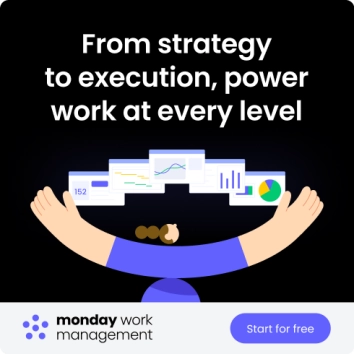Professionals can arrive at project management through many paths. Some project management beginners opt for training courses or get degrees, while others learn from experience and leverage skills they already have to become project managers. For those just beginning your journey, we’ll go through the core phases, methods, and skills to create a solid foundation for your career.
In this guide to project management for beginners, we’ll also provide you with some handy starter templates to help you manage your projects, no matter which level you’re at. Let’s dive in.
TL;DR: Effective project management involves guiding a project through five key phases: initiation, planning, execution, monitoring, and closure. For beginners, success hinges on understanding core methodologies like Agile and Waterfall, developing essential skills, and using the right software to stay organized and collaborative.
What is project management?
What is project management?
Project management is the process of planning, executing, and overseeing a team’s work to achieve specific goals and meet success criteria within a defined timeline. It involves managing resources, schedules, budgets, and communication to guide a project from start to finish.
Put simply, if you want to complete a project successfully, good project management is foundational. But the value gained from strong project management goes much deeper than just checking off tasks.
Why is project management so important?
Why is project management so important?
With the right tools and techniques, a project manager builds a roadmap that everyone on the team can follow. The project manager assigns tasks, facilitates hand-offs, and keeps communication flowing to ensure progress stays on schedule. They know who’s working on what and how to keep the entire team moving in the same direction. The benefits are myriad:
- Improved collaboration: When everyone on the team knows what tasks are in the pipeline and who’s working on them, collaboration is easy. A centralized platform like monday.com ensures that if someone has a question, they can go straight to the source and see all related context.
- Increased clarity and less confusion: Good project management means every team member has a clearly defined role and understands their responsibilities. This reduces the likelihood of unfinished tasks, missing details, and general uncertainty.
- More effective and motivated teams: A clear plan with measurable milestones gives everyone involved a sense of ownership. Team members can see how their individual contributions impact the overall project, which helps keep them motivated and focused on their goals.
Given these benefits, it’s no wonder companies are doubling down on investments in project management. According to the Project Management Institute, the global economy will need 25 million new project professionals by 2030. This makes now the perfect time to begin implementing proven project management practices and software.
The 5 phases of the project management lifecycle
The 5 phases of the project management lifecycle
Every project, regardless of size or industry, follows a similar path from start to finish. Understanding this lifecycle is a fundamental part of project management for beginners.
Phase 1: Initiation
This is where the project is born. The goal is to define the project at a high level, identify key stakeholders, and determine its overall feasibility. You’ll create a project charter or a business case that outlines the project’s objectives, scope, and the problem it’s intended to solve.
Phase 2: Planning
Once the project is approved, it’s time to build a detailed roadmap. The project planning phase involves setting goals, defining the scope, identifying tasks and dependencies, estimating timelines and budgets, and allocating resources. This is where tools like monday.com’s project management plan template become invaluable, helping you organize everything in one place.
Phase 3: Execution
With a solid plan in place, the team gets to work. The execution phase is all about completing the tasks and activities outlined in the project plan. For a project manager, this phase involves leading the team, facilitating communication, and ensuring everyone has what they need to do their best work.
Phase 4: Monitoring and control
This phase runs concurrently with execution. As the project progresses, you need to monitor its performance to ensure it stays on track, on time, and within budget. This involves tracking key performance indicators (KPIs), managing changes to the plan, and resolving any issues that arise. Dashboards on monday.com provide real-time visibility, making it easy to track progress at a glance.
Phase 5: Closure
The final phase is about formally closing the project. This includes delivering the final product, releasing project resources, and conducting a post-mortem or lessons-learned session. Celebrating the team’s success is a crucial step to build morale for future projects.
Common project management methodologies for beginners
Common project management methodologies for beginners
Methodologies provide a set of principles and practices for managing a project. Choosing one that matches your project’s needs is a great way to set a foundation for success.
Project management methodologies
- Waterfall: As one of the oldest methodologies, Waterfall is a linear approach where each project phase must be completed before the next one begins. It works best for projects with clearly defined requirements and minimal expected changes.
- Agile: The Agile methodology is an iterative approach focused on flexibility and collaboration. Work is broken down into short cycles called sprints, allowing teams to adapt to changes quickly. It’s ideal for projects where requirements are expected to evolve.
- Scrum: Scrum is a popular framework within the Agile methodology. It uses specific roles (like a Scrum Master), events (like daily stand-ups), and artifacts (like a product backlog) to manage complex projects.
- Lean: The Lean methodology focuses on maximizing value while minimizing waste. It’s about streamlining processes and eliminating any activity that doesn’t add value to the final product, leading to greater efficiency.
Project management frameworks
Frameworks are tools and structures you can use within a methodology to organize work.
- Kanban: Kanban is a visual framework that uses boards with columns and cards to represent tasks and workflow stages. These visual cues make it easy for teams to understand project status and task flow at a glance.
- Gantt charts: A Gantt chart is a bar chart that illustrates a project schedule. It shows the start and end dates of tasks, dependencies between them, and overall project progress against a timeline.
Essential skills for a new project manager
Essential skills for a new project manager
While methodologies and frameworks provide structure, a project manager’s skills are what truly drive a project forward. Here are some of the most important ones for beginners to develop.
- Communication: This is arguably the most critical skill. You need to be able to clearly articulate goals, provide feedback, and keep stakeholders informed in a way that everyone understands.
- Leadership: A good project manager motivates the team, fosters a collaborative environment, and guides everyone toward a common goal without micromanaging.
- Organization and planning: You must be able to take a large, complex goal and break it down into manageable tasks, create realistic timelines, and keep track of all the moving parts.
- Problem-solving: Projects rarely go exactly as planned. The ability to think critically, identify issues, and find effective solutions is essential.
- Risk management: This involves identifying potential project risks before they happen and developing contingency plans to mitigate their impact.
How AI is making project management easier for beginners
How AI is making project management easier for beginners
Artificial intelligence is no longer a futuristic concept—it’s a practical tool that can significantly simplify project management, especially for those just starting out. On platforms like monday.com, AI is built directly into your workspace to handle complex or tedious work.
For a beginner, AI can act as a helpful assistant by:
- Automating task creation: Instead of manually breaking down a large objective, you can use AI to automatically generate a list of tasks and sub-items, saving you time and ensuring nothing is missed.
- Summarizing long documents: AI can quickly summarize lengthy reports, meeting notes, or email threads, allowing you to grasp key takeaways and action items instantly.
- Improving communication: AI features can help you compose clear and concise emails or project updates, ensuring your communication is always professional and effective.
- Identifying risks: Advanced AI can analyze project data to flag potential risks or bottlenecks before they become major problems, giving you a chance to act proactively.
By automating routine work and providing smart suggestions, AI empowers new project managers to focus on strategic thinking, team leadership, and decision-making.
Choosing the right project management software
Choosing the right project management software
Finding the right project management software is just as crucial as choosing the right methodology. The best platforms are flexible enough to fit your team’s approach. A Work OS like monday.com makes that possible with:
- Custom workflows: You can easily create and manage processes that fit your team’s unique needs. Start with a template and use drag-and-drop blocks to build the perfect workflow for any project.
- Simple scheduling: Keeping projects on schedule is a core function of project management. Features like due date columns and automated reminders make a project manager’s job much easier. You can also create dashboards linked to every team member to track progress and timelines.
- Seamless collaboration: With files, communications, and issue logs centralized in one place, everyone on the team is always on the same page. This transparency is key to keeping projects moving forward smoothly.
As a Work OS, monday.com provides you and your team with the tools necessary to collaborate, communicate, and keep every project on time and on budget.
Get started with these beginner-friendly project management templates
Get started with these beginner-friendly project management templates
We have hundreds of templates to choose from, but the ones below give you an easy-to-use starting point for project management on monday.com.
Project management plan template
Planning is the first step of any new project, and the monday.com project management plan template lets you hit the ground running. This template organizes a project according to phases, so you can dive in and start adding tasks. As work progresses, you can keep an eye on the status of each task by drilling down to check on updates, activity, and files.
Single project template
If you’re looking for a productive way to organize a single project, our single project template is for you. This template has everything you need to track the status of activities across every phase of your project. It also has a handy Gantt view that shows you a high-level overview of the project as it progresses.
Ready to manage your first project like a pro? Get started with monday.com’s intuitive Work OS.
 Get started
Get started 


